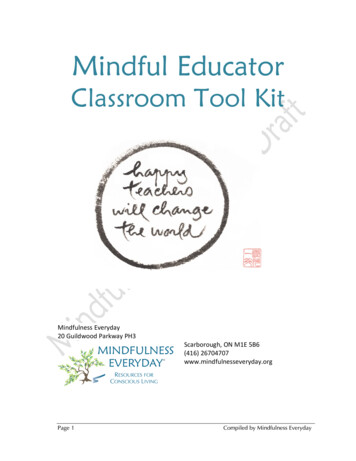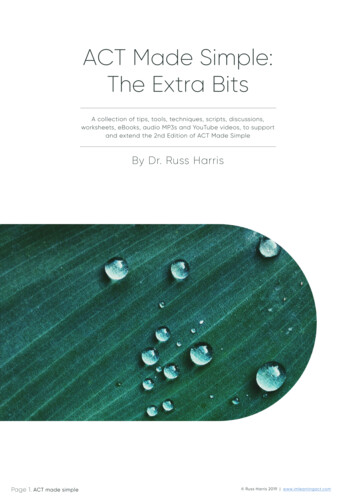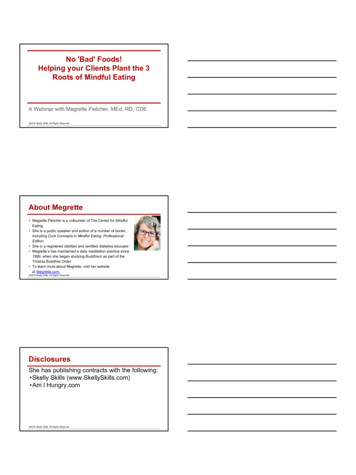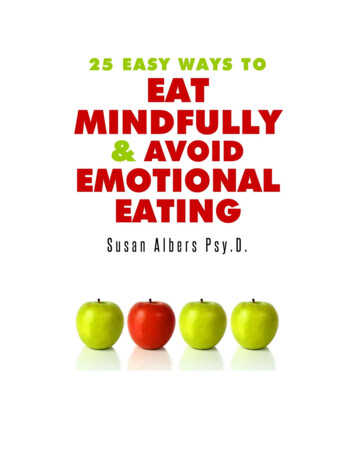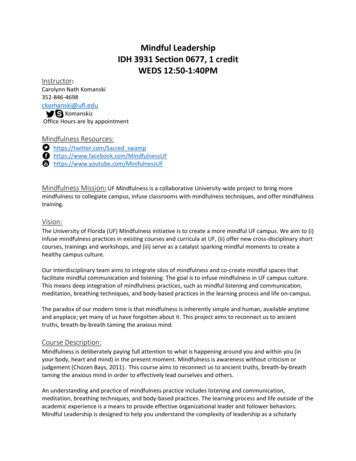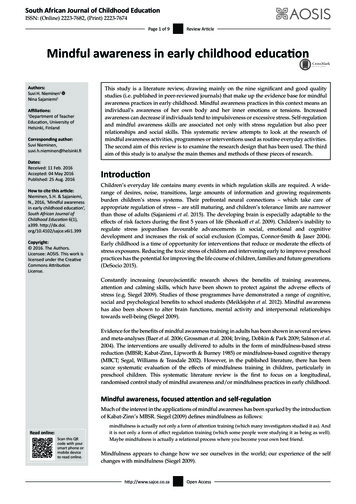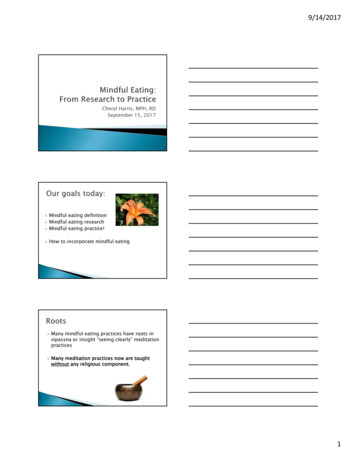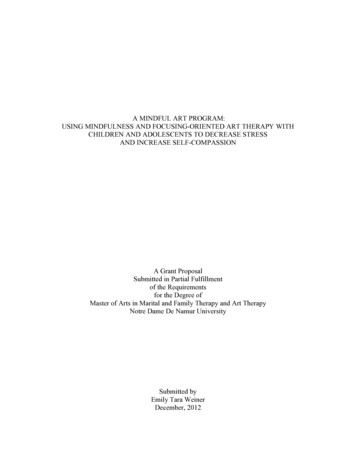
Transcription
A MINDFUL ART PROGRAM:USING MINDFULNESS AND FOCUSING-ORIENTED ART THERAPY WITHCHILDREN AND ADOLESCENTS TO DECREASE STRESSAND INCREASE SELF-COMPASSIONA Grant ProposalSubmitted in Partial Fulfillmentof the Requirementsfor the Degree ofMaster of Arts in Marital and Family Therapy and Art TherapyNotre Dame De Namur UniversitySubmitted byEmily Tara WeinerDecember, 2012
SignaturesI certify that I have read this thesis and that, in my opinion, it meets the thesis requirementfor the Master of Arts in Marriage and Family Therapy and Art Therapy degree.Amy Backos, Ph.D., ATR-BCAssistant ProfessorThesis DirectorI certify that I have read this thesis and that, in my opinion, it meets the thesis requirementfor the Master of Arts in Marriage and Family Therapy and Art Therapy degree.Laury Rappaport, Ph.D., LMFT, ATR-BCProfessor, Five Branches UniversitySecond ReaderApproved for submission to the College of Arts and Sciences at Notre Dame de NamurUniversity.John Lemmon, Ph.D.Dean of the College of Arts and Sciences
AcknowledgementsI am infinitely grateful to Dr. Laury Rappaport, Daniel Rechtschaffen of theMindful Education Institute (MEI), and Megan Cowen of Mindful Schools for theirinitial inspiration for my vision to create this Mindful Art Program for children. I thankthem and everyone from the FOAT (Focusing-Oriented Art Therapy) and MEI(Mindfulness Education Institute) communities from the center of my being, for theircontinued inspiration and support.I would like to thank Dr. Amy Backos for being my thesis advisor. I would alsolike to thank Dr. Laury Rappaport, again, for being my second reader, and greatestmentor. In addition, I would also like to thank Dr. Richard Carolan as my ResearchMethods professor.I would like to thank the Omega Institute and The Omega Teen Camp forallowing me to run the initial pilot for the Mindful Art Program, and Joya Deutsch ofRocketship Discovery Prep elementary school and Rocketship Education for being mysponsoring agency for this grant. In addition, I would also like to thank my family fortheir unconditional support throughout my entire graduate career.Mostly, I would like to thank the children and adolescents who participated andwill participate in and continue to inspire the vision for this Mindful Art Program,including my own inner child, who would loved to have learned these tools and skillsearlier in her precious life!
Table of ContentsTitle Page . iSignature Page .iiAcknowledgement Page .iiiTable of Contents .iv-viList of Tables and Figures .viiAbstract 1Sponsoring Letter .2Introduction of Sponsoring Agency .3Problem Statement. .5Introduction .5Stress in Childhood and Adolescents .5Mindfulness-Based Stress Reduction (MBSR) 7MBSR with Children and Adolescents 8Mindful Schools .10Mindfulness and Prevention .11Focusing-Oriented Art Therapy (FOAT) .13FOAT with Children and Adolescents .14Art-Based Mindfulness Programs for Children .16Mindful Art Program .17Purpose of Grant 18Hypothesis and Research Question 19Objectives . 20Methodology .21Hypothesis .21Research Design .21Participants .21Location .22Instruments of Measure .23Art Materials .30Procedure . 30Data Collection and Analysis .33Risks .36
Benefits .36Confidentiality .37Human Participant Consideration .38Evaluation .39Future Funding .41Budget 42Appendix A: Literature Review .44Introduction 45Effects of Stress on Child Neurodevelopment .45Effects of Toxic Stress in Childhood .47Neuroscience of Stress .49Neuroscience of Mindfulness .50Mindfulness-Based Stress Reduction (MBSR) .54MBSR with Children and Adolescents .55Mindfulness-Based Cognitive Therapy (MBCT) .56MBCT with Children and Adolescents .56Other Mindfulness-Based Therapies: .57Dialectical Behavior Therapy (DBT) .57Acceptance and Commitment Therapy (ACT) .57Mindfulness in Education and Social Emotional Learning (SEL) Movements .59Mindfulness and Positive Psychology .61Mindfulness and Prevention .62Mindfulness and Empathy .64Mindfulness-Based Art Therapy (MBAT) .65Focusing-Oriented Art Therapy (FOAT) .66Mindfulness and Art with Children and Adolescents .67Appendix B: Letters of Support .70Appendix C: Consent Forms (English) .73Letter of Intent .74Parent Informed Consent Form . . . .75Child Informed Assent Form . . .78Permission to Use Artwork Form .79Demographic Form . 80Debriefing Statement .81
Appendix D: Consent Forms (Spanish) .82Appendix E: Evaluation Measures. .90Perceived Stress Scale (PSS) .91Likert Stress Scale . .94Self-Compassion Scale-Child (SCS-C) .95Child and Adolescent Mindfulness Measure (CAMM) . .99Program Evaluation .101Appendix F: Mindful Art Program Curriculum . .103Week 1. Mindfulness Fundamentals: Mindful Listening--Thought Jars . 104Week 2. Mindfulness Fundamentals: Mindful Bodies--Body Drawings .106Week 3. FOAT Exercise: Clearing a Space with Art--Treasure Boxes . 108Week 4. FOAT Exercise: “All-Fine Place”--Self-Gratitude Journals 110Week 5. FOAT Exercise: Asking and Receiving--Magic Eight Ball/Wells 111Week 6. The Focusing Attitude with Self-- Inner Friendship Drawings .113Week 7. The Focusing Attitude with Others--Inner Friendship Group Poems.115Week 8. Closure: FOAT Exercise: Carrying it Forward--Group Mural . .117Appendix G: Mindful Art Program Templates and Handouts .118Body Cut-Out Template .119Inner Friendship Body Cut-Out Template . 120Magic Eight Ball Drawing Template . 121Wishing Well Template . 122Emotions Word List Handout . 123Body Sensations Word List Handout . 124Appendix H: Mindful Art Program Art Examples (from Omega Teen Camp) . 125Appendix I: Resume .134Appendix J: Grant Forms . .136Funding Source Identification Form .137Request for Proposal from Funding Source .138Copy of Proposal Forwarded to Funding Source .139References . .143
List of Tables and FiguresTable 1. Mindful Art Program Curriculum Overview . .32Figure 1. “All-Fine Place” Journal Cover: Tree Time; time stands still .126Figure 2. “All-Fine Place” Journal Cover: The only tool you need is kindness 126Figure 3. “All-Fine Place” Journal Cover: Home but in a different world .126Figure 4. “All-Fine Place” Journal Cover: With Love I Stare .127Figure 5. “All-Fine Place” Journal Cover: Hummingbird by a Waterfall .127Figure 6. Self-Gratitude Practice: Grateful .128Figure 7. Self-Gratitude Practice: Gifts .128Figure 8. Self-Kindness Practice 128Figure 9. Self-Compassion Mandala: Heartful Web of Life .129Figure 10. Self-Compassion Mandala: Energies of Love .129Figure 11. Self-Compassion Mandala: Life’s Wish for Love .130Figure 12. Self-Compassion Mandala: Embrace It All .130Figure 13. Self-Compassion Mandala: Seeds of Compassion .131Figure 14. Self-Compassion Mandala: Waves of Love and Light 131Figure 15. Self-Compassion Mandala (Facilitator I): The Eye of Love 132Figure 16. Self-Compassion Mandala (Facilitator II): Radiating Light of Love .132
SignaturesI certify that I have read this thesis and that, in my opinion, it meets the thesis requirementfor the Master of Arts in Marriage and Family Therapy and Art Therapy degree.Amy Backos, Ph.D., ATR-BCAssistant ProfessorThesis DirectorI certify that I have read this thesis and that, in my opinion, it meets the thesis requirementfor the Master of Arts in Marriage and Family Therapy and Art Therapy degree.Laury Rappaport, Ph.D., LMFT, ATR-BCProfessor, Five Branches UniversitySecond ReaderApproved for submission to the College of Arts and Sciences at Notre Dame de NamurUniversity.John Lemmon, Ph.D.Dean of the College of Arts and Sciences
AcknowledgementsI am infinitely grateful to Dr. Laury Rappaport, Daniel Rechtschaffen of theMindful Education Institute (MEI), and Megan Cowen of Mindful Schools for theirinitial inspiration for my vision to create this Mindful Art Program for children. I thankthem and everyone from the FOAT (Focusing-Oriented Art Therapy) and MEI(Mindfulness Education Institute) communities from the center of my being, for theircontinued inspiration and support.I would like to thank Dr. Amy Backos for being my thesis advisor. I would alsolike to thank Dr. Laury Rappaport, again, for being my second reader, and greatestmentor. In addition, I would also like to thank Dr. Richard Carolan as my ResearchMethods professor.I would like to thank the Omega Institute and The Omega Teen Camp forallowing me to run the initial pilot for the Mindful Art Program, and Joya Deutsch ofRocketship Discovery Prep elementary school and Rocketship Education for being mysponsoring agency for this grant. In addition, I would also like to thank my family fortheir unconditional support throughout my entire graduate career.Mostly, I would like to thank the children and adolescents who participated andwill participate in and continue to inspire the vision for this Mindful Art Program,including my own inner child, who would loved to have learned these tools and skillsearlier in her precious life!
Table of ContentsTitle Page . iSignature Page .iiAcknowledgement Page .iiiTable of Contents .iv-viList of Tables and Figures .viiAbstract 1Sponsoring Letter .2Introduction of Sponsoring Agency .3Problem Statement. .5Introduction .5Stress in Childhood and Adolescents .5Mindfulness-Based Stress Reduction (MBSR) 7MBSR with Children and Adolescents 8Mindful Schools .10Mindfulness and Prevention .11Focusing-Oriented Art Therapy (FOAT) .13FOAT with Children and Adolescents .14Art-Based Mindfulness Programs for Children .16Mindful Art Program .17Purpose of Grant 18Hypothesis and Research Question 19Objectives . 20Methodology .21Hypothesis .21Research Design .21Participants .21Location .22Instruments of Measure .23Art Materials .30Procedure . 30Data Collection and Analysis .33Risks .36
Benefits .36Confidentiality .37Human Participant Consideration .38Evaluation .39Future Funding .41Budget 42Appendix A: Literature Review .44Introduction 45Effects of Stress on Child Neurodevelopment .45Effects of Toxic Stress in Childhood .47Neuroscience of Stress .49Neuroscience of Mindfulness .50Mindfulness-Based Stress Reduction (MBSR) .54MBSR with Children and Adolescents .55Mindfulness-Based Cognitive Therapy (MBCT) .56MBCT with Children and Adolescents .56Other Mindfulness-Based Therapies: .57Dialectical Behavior Therapy (DBT) .57Acceptance and Commitment Therapy (ACT) .57Mindfulness in Education and Social Emotional Learning (SEL) Movements .59Mindfulness and Positive Psychology .61Mindfulness and Prevention .62Mindfulness and Empathy .64Mindfulness-Based Art Therapy (MBAT) .65Focusing-Oriented Art Therapy (FOAT) .66Mindfulness and Art with Children and Adolescents .67Appendix B: Letters of Support .70Appendix C: Consent Forms (English) .73Letter of Intent .74Parent Informed Consent Form . . . .75Child Informed Assent Form . . .78Permission to Use Artwork Form .79Demographic Form . 80Debriefing Statement .81
Appendix D: Consent Forms (Spanish) .82Appendix E: Evaluation Measures. .90Perceived Stress Scale (PSS) .91Likert Stress Scale . .94Self-Compassion Scale-Child (SCS-C) .95Child and Adolescent Mindfulness Measure (CAMM) . .99Program Evaluation .101Appendix F: Mindful Art Program Curriculum . .103Week 1. Mindfulness Fundamentals: Mindful Listening--Thought Jars . 104Week 2. Mindfulness Fundamentals: Mindful Bodies--Body Drawings .106Week 3. FOAT Exercise: Clearing a Space with Art--Treasure Boxes . 108Week 4. FOAT Exercise: “All-Fine Place”--Self-Gratitude Journals 110Week 5. FOAT Exercise: Asking and Receiving--Magic Eight Ball/Wells 111Week 6. The Focusing Attitude with Self-- Inner Friendship Drawings .113Week 7. The Focusing Attitude with Others--Inner Friendship Group Poems.115Week 8. Closure: FOAT Exercise: Carrying it Forward--Group Mural . .117Appendix G: Mindful Art Program Templates and Handouts .118Body Cut-Out Template .119Inner Friendship Body Cut-Out Template . 120Magic Eight Ball Drawing Template . 121Wishing Well Template . 122Emotions Word List Handout . 123Body Sensations Word List Handout . 124Appendix H: Mindful Art Program Art Examples (from Omega Teen Camp) . 125Appendix I: Resume .134Appendix J: Grant Forms . .136Funding Source Identification Form .137Request for Proposal from Funding Source .138Copy of Proposal Forwarded to Funding Source .139References . .143
List of Tables and FiguresTable 1. Mindful Art Program Curriculum Overview . .32Figure 1. “All-Fine Place” Journal Cover: Tree Time; time stands still .126Figure 2. “All-Fine Place” Journal Cover: The only tool you need is kindness 126Figure 3. “All-Fine Place” Journal Cover: Home but in a different world .126Figure 4. “All-Fine Place” Journal Cover: With Love I Stare .127Figure 5. “All-Fine Place” Journal Cover: Hummingbird by a Waterfall .127Figure 6. Self-Gratitude Practice: Grateful .128Figure 7. Self-Gratitude Practice: Gifts .128Figure 8. Self-Kindness Practice 128Figure 9. Self-Compassion Mandala: Heartful Web of Life .129Figure 10. Self-Compassion Mandala: Energies of Love .129Figure 11. Self-Compassion Mandala: Life’s Wish for Love .130Figure 12. Self-Compassion Mandala: Embrace It All .130Figure 13. Self-Compassion Mandala: Seeds of Compassion .131Figure 14. Self-Compassion Mandala: Waves of Love and Light 131Figure 15. Self-Compassion Mandala (Facilitator I): The Eye of Love 132Figure 16. Self-Compassion Mandala (Facilitator II): Radiating Light of Love .132
AbstractThis grant proposal’s hypothesis is that an eight-week Mindful Art Program willdecrease stress and increase Self-Compassion in children, ages 9 and 10. This pilotprogram will be conducted at Rocketship Discovery Prep, a charter elementary school inSan Jose, California. The Mindful Art Program will be conducted with a total of fourclassrooms (three fourth grade classes and one fifth grade class), during one-hoursessions in the schoolday, once a week, for eight weeks. The Mindful Art Program isbased on both the Mindful Schools curriculum and Dr. Laury Rappaport’s, FOAT(Focusing-Oriented Art Therapy). The Mindful Art Program is also based on a wellnessand prevention model, within the field of positive psychology. Results of this grant andfollow-up research study should show a decrease in stress, as measured by the PerceivedStress Scale (PSS) and an increase in Self-Compassion, as measured by the SelfCompassion Scale-Children (SCS-C). Teacher report on the Child Behavior Checklist(CBC-L) should show a reduction in problem behaviors associated with child stress. Inaddition, the children should show an increase in Mindfulness skills, as measured by theChild and Adolescent Mindfulness Measure (CAMM), adding validity to the Mindful ArtProgram as a Mindfulness-based intervention.
(sponsoring letter on org. letterhead)DateTo Whom It May Concern:I am writing this letter in support of Emily Weiner who is seeking a grant to fund andcarry out research concerning her Mindful Art Program that this sponsoring agency,Rocketship Discovery Prep, hopes to offer to its forth and fifth grade students.Rocketship Discovery Prep is an elementary school located in San Jose, California, whichis apart of Rocketship Education, a national, non-profit elementary charter schoolnetwork that opened the nation’s first hybrid school in 2007, pioneering the RocketshipModel. The Rocketship Model delivers on these four ambitions: innovation,empowerment, leadership and impact. It includes exceptional classroom teaching andindividualized learning to enable students to master basic skills and higher order thinkingskills, and an operational approach that minimizes expensive, unnecessary redundancy,while supporting academic innovation and excellence. Rocketship Education intends toexpand across the U.S. to serve more low-income students in cities that have the urgencyto eliminate the achievement gap.At Rocketship Discovery Prep, we are committed to academic excellence in anenvironment that teaches, reinforces and celebrates our five core values: respect,responsibility, persistence, empathy and creative expression. I am confident that EmilyWeiner’s Mindful Art Program will serve our core values of empathy and creativeexpression.Therefore, I support the grant research as proposed by Emily Weiner and invite her toconduct her Mindful Art Program at Rocketship Discovery Prep. We believe that herstudy will demonstrate how this Mindful Art Program can decrease stress and increaseempathy in our students.Sincerely,Joya DeutschPrinicpal
Introduction to Sponsoring AgencyRocketship Discovery Prep is an elementary school located in San Jose,California, within Santa Clara County. Rocketship Discovery Prep is apart of RocketshipEducation, a national, non-profit elementary charter school network that opened thenation’s first hybrid school in 2007, pioneering the Rocketship Model.The Rocketship Model delivers on these four ambitions: innovation,empowerment, leadership and impact. It includes exceptional classroom teaching andindividualized learning to enable students to master basic skills and higher order thinkingskills, and an operational approach that minimizes expensive, unnecessary redundancy,while supporting academic innovation and excellence.Rocketship Education intends to expand across the U.S. to serve more lowincome students in cities that have the urgency to eliminate the achievement gap.
Problem StatementIntroductionStress is an epidemic in our current culture in the United States(Ryan, 2012). “All across America, people are feeling squeezed and exhausted—runningfaster and faster yet falling further behind people are maxed out and crunched. Theyare running harder on an economic treadmill that just keeps getting faster and steeper.”(Ryan, 2012, p. 9). The struggling state of our current economy, and the ever-increasingpace of our culture, technology, war, political and environmental concerns are allcommon sources of stress for adults in the U.S. (Ryan, 2012). “Stress” is defined here asthe body’s reaction to a perceived difficulty or challenge, that disturbs its equilibrium.The term “stressor” is defined as the perceived difficulty or challenge that mayprecipitate stress (Terzien, Moore, & Nguyen, 2010). Stress is now a well-proven riskfactor for mental health illness and physical illness (Terzien et al., 2010).Stress in Children and AdolescentsAdults, however, are not the only ones who experience stress. Adolescents andchildren are also deeply affected by the state of our economy, parental job loss, state andbudget cuts and the ever-increasing pace of our culture and technology (Ryan, 2012;Siegel, 2012). With the advent of ever-new, constant, streaming media at their fingertips,children and teens are being bombarded with more external stimulation than ever before(Ryan, 2012; Siegel, 2012). Academic and extra-curricular expectations and pressures inour country are also constantly increasing for children and adolescents (Ryan, 2012).
Children are being expected to learn more and to do more at earlier and earlier ages(Ryan, 2012). The focus in our school systems is on academic performance and successand on the cultivation of purely academic intelligence; the focus in schools is not on thecultivation of emotional intelligence and other life coping skills including stressmanagement, Self-Compassion, compassion for others, and interpersonal skills--elementswhich are all crucial for coping with and thriving throughout life and in relationship toothers, as well as in relationship to the larger global community and to the Earth itself(Ryan, 2012).Adolescents and children experience some common stressors in their daily lives.Worrying about schoolwork and academic pressures, peer relationships and bullying,home life, and changing bodies and self-image are just some of the daily stressesexperienced by school-age children and adolescents (Smith-Vogtmann, 2009).Stress can have a huge, negative impact on child development, both in terms ofneuro-development and mental-emotional development (Middlebrooks & Audage,Centers for Disease Control, 2008). Stress can disrupt early brain development andcompromise functioning of the nervous and immune systems (Middlebrooks & Audage,CDC, 2008). In addition, childhood stress can lead to health problems later in lifeincluding alcoholism, depression, eating disorders, heart disease, cancer, and otherchronic diseases (Middlebrooks & Audage, CDC, 2008). Therefore, addressing,managing and preventing stress experienced by children and adolescents during thesecrucial developmental life stages becomes even more critical for their long-term healthand well-being (CDC, 2008; Terzien, et al. 2010).Although stress can be problematic for all children and adolescents, children and
adolescents from low socioeconomic backgrounds may be even more likely to experiencechronic and/or high levels of stress (Terzien et al., 2010; Ryan, 2012). Children andadolescents who live in low-resource, high crime neighborhoods may experience addedand chronic stressors of poverty, failing educational systems and exposure to communityviolence (Sibinga et al., 2011). Research shows that chronic stress--stress experiencedover a long period of time--can have a negative effect on learning and academicachievement, as well as psychological and physical wellbeing (Sibinga et al., 2011).Chronic stress can lead to physical illness and psychological disorders such as anxietyand depression (Sibinga et al., 2011). How children cope with and manage stressdepends on the resources that are available to them and whether they have the skills toutilize these resources (Terzien et al., 2010). Mindfulness–Based Stress Reduction is onesuch resource that can help mitigate the effects of stress.Mindfulness-Based Stress Reduction (MBSR)Mindfulness is now being widely used as a helpful stress management skill foradults. Jon Kabat-Zinn pioneered the program of Mindfulness-Based Stress Reduction(MBSR) for adults in 1979 at the Center for Mindfulness (CFM), within the University ofMassachusetts Medical School (Kabat-Zinn, 1990). Kabat-Zinn defines “Mindfulness”as “the awareness that emerges through paying attention on purpose, in the presentmoment, and non-judgmentally to the unfolding of experience moment-tomoment’’(Kabat-Zinn, 1990, p. 4). For purposes of this research, Kabat-Zinn’s definitionof Mindfulness will be used.Kabat-Zinn’s MBSR program is an eight-week program, focusing on regular
Mindfulness meditation exercises (Kabat-Zinn, 1990). These Mindfulness exercisesinclude the “body scan”, using the breath as an “anchor” for attention, sitting meditation,walking and movement meditations, as well as informal Mindfulness practices in whichparticipants intentionally bring mindful awareness to activities of daily life such as eating(Kabat-Zinn, 1990). The MBSR program also includes weekly group sessions and homepractice (Kabat-Zinn, 1990). Through group and home practices, participants developMindfulness skills and attitudes including focused attention, sustaining and switchingattention, accepting their present moment experience, and noticing felt sensations in thebody, without judgment (Kabat-Zinn, 1990). Kabat-Zinn strongly upholds that MBSRteachers have extensive personal experience of Mindfulness practices before teaching theprogram to clients (Kabat-Zinn, Mindful Schools Benefit, February 17, 2012). Researchhas shown that the MBSR program is reliably effective in reducing symptoms of stress,anxiety and depression in adults (Kabat-Zinn, 2003; Baer, 2003; Bishop et al., 2004).MBSR with Children and AdolescentsIn recent years, there have been adaptations to the MBSR program for adolescentsand children (Saltzman & Goldin, 2008). Gina Biegel (2009) has adapted the MBSRprogram specifically for adolescents in her program “Stressed Teens”, and Amy Saltzmanhas adapted the MBSR program for children. For her MBSR program for children,Saltzman uses the same Mindfulness practices outlined in Kabat-Zinn’s MBSR programfor adults, but makes various age-appropriate adaptations for children (Saltzman &Goldin, 2008). For example, Saltzman uses shorter time frames for the Mindfulnessexercises and uses child-friendly language and metaphors (Saltzman & Goldin, 2008).
In Saltzman’s Mindfulness exercise called, “Thought Parade”, she uses themetaphor of a parade to help the children participants identify when they are “marchingwith the parade” (lost in thought), rather than “watching the parade go by” (observingtheir thoughts) (Saltzman & Goldin, 2008). In Saltzman’s Mindfulness exercise,“ Flashlight ”, Saltzman uses the metaphor of a flashlight to help the child participantslearn how to keep mindful attention in the body; Saltzman invites the children to “shinethe flashlight of their attention” on different parts of the body and the sensations felt atthis location in the body (Saltzman & Goldin, 2008); Saltzman then invites the childrento “open the lens of their flashlight” to include awareness of everything and then to“close the lens” to focus on only one thing, such as their breath (Saltzman & Goldin,2008). These exercises help the child participants learn how to have more choice interms of where to keep their focus, attention and awareness (Saltzman &Goldin, 2008).Saltzman also uses imagery and art to help make the Mindfulness exercises fun andengaging for children (Saltzman & Goldin, 2008).For one of the at-home, “Feelings Practices”, Saltzman asks children to makeartistic representations of two feelings that they had during the meditations (Saltzman &Goldin, 2008). According to Saltzman, this “helps the children become morecomfortable with identifying and expressing their emotions” (Saltzman & Goldin, 2008,p. 148). Saltzman instructed facilitators to explain to the children that there may be“layers of feelings or that the feelings may be subtle or somewhat shy” (Saltzman &Golden, 2008, p. 148). After naming the feelings, the children are encouraged to noticewhere feelings are experienced in the body (location) (i.e. belly, ch
Mindful Education Institute (MEI), and Megan Cowen of Mindful Schools for their initial inspiration for my vision to create this Mindful Art Program for children. I thank them and everyone from the FOAT (Focusing-Oriented Art Therapy) and MEI (Mindfulness Education Inst


